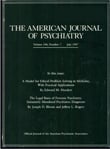It is an unfortunate reality that life's unfairness starts at the beginning of life. Together with the disparate status and role opportunities accompanying the accident of birth, each child arrives in the world at a cultural time and place in which certain human characteristics are valued and others are maladaptive. The nature-nurture debate has long embodied an effort to resolve these existential inequities by looking for causes and remedies of negatively valued behaviors in the childrearing environment. Nowhere is this more evident than in Western cultures, where many parents of difficult children—mothers in particular—have developed a learned guilt neurosis of defective parenting.
Child psychiatrists Stella Chess and Alexander Thomas, long known for their series Annual Progress in Child Psychiatry and Child Development, have ascribed some of this unnecessary guilt to faulty psychoanalytic theory. In the 1950s, Chess and Thomas began the New York Longitudinal Study of Child Temperament when the relationships they saw in their practice could not be reconciled with the explanatory models of their training. They saw cases of good parents with temperamentally difficult children, children whose temperamental strengths enabled them to cope successfully with highly dysfunctional parents, and vast differences among siblings raised in the same environment. For many of the children seen in private practice, there seemed to be a parsimonious explanation for disturbed behaviors: “Expectations that were inappropriate for the child's specific traits would create stress and anxiety, which would cause some kind of behavioral problem.” The authors recognized the need for research to clarify and categorize traits so that parents could recognize the stress triggers and modify their expectations to match their child's temperament.
Beginning in 1956, the New York Longitudinal Study of Child Temperament collected enormous amounts of data on childrearing practices and behaviors among 138 middle-class white children and 95 lower-socioeconomic-class Puerto Rican children, from infancy to 7 or 8 years of age. Included were results of psychiatric interviews and special sensory, neurological, psychological, and IQ testing. Analysis yielded nine categories of “behavioral style”: activity level, rhythmicity (regularity), approach versus withdrawal, adaptability, threshold of responsiveness, intensity of reaction, quality of mood, distractibility, and attention span and perspective. Cluster analysis indicated three clear temperament constellations, evident in about two-thirds of the sample. Easy children, 40% of the total, showed regularity, positive responses to new stimuli, and high adaptability to change. They related well to strangers and new situations and accepted frustration well. Difficult children, about 10%, showed irregularity in biological function, withdrawal from new stimuli, nonadaptability to change, irregular sleep and feeding schedules, and prolonged adjustment to new situations. Frustration produced tantrums. Slow-to-warm-up children, about 15%, combined mildly negative responses to new stimuli with slow adaptability after repeated contact. In contrast to difficult children, they showed mild intensity of reactions, whether positive or negative, and less irregularity of biological functions. If allowed to reexperience new situations over time and without pressure, the slow-to-warm-up child gradually came to show positive interest and involvement. The remaining 35% of the children showed varied clusters of behavioral styles, all within normal limits.
From the New York Longitudinal Study of Child Temperament data, Chess and Thomas formulated a concept of goodness of fit between parental expectations and children's temperament, which became the focus of their therapeutic interventions. Parents were taught to recognize and make appropriate adjustments for such phenomena as biological rhythms, sleep-waking schedules, intensity of response, distractibility, and the like. The authors found that guiding parents to modify their own behavior to correspond with their children's temperaments was more effective than their former emphases on conflicts, defenses, and anxieties.
In many ways, the Chess and Thomas approach parallels the empirical effectiveness of psychoeducational interventions with families of adults with major psychotic disorders. Here, interventions are geared toward ensuring a goodness of fit between the caregiving environment and cognitive and attentional deficits, between stimulus levels and thresholds of psychophysiological arousal. In each of these models, psychodynamic therapies have been supplanted by an essentially educational approach to accommodate the interpersonal environment to biologically based characteristics.
Temperament: Theory and Practice is written in an easy narrative style that is a pleasure to read. Case examples are interesting and instructive as models. There are chapters on prevention and early intervention, temperament therapy with handicapped children as well as adolescents and adults, and biological research on temperament. Although the authors state firmly that temperament is biologically based, they also discuss the dynamic interplay of traits and environment, the cultural patterning of familial response, and beginning attempts to study consistency and change. Any discussion of innate biological differences is fraught with political dangers, however, both in attribution and application. Chess and Thomas' clear respect for their subjects and their willingness to teach others to value and work toward accommodation of human diversity elicit an appreciation of their basic humanity as well as their skills.

